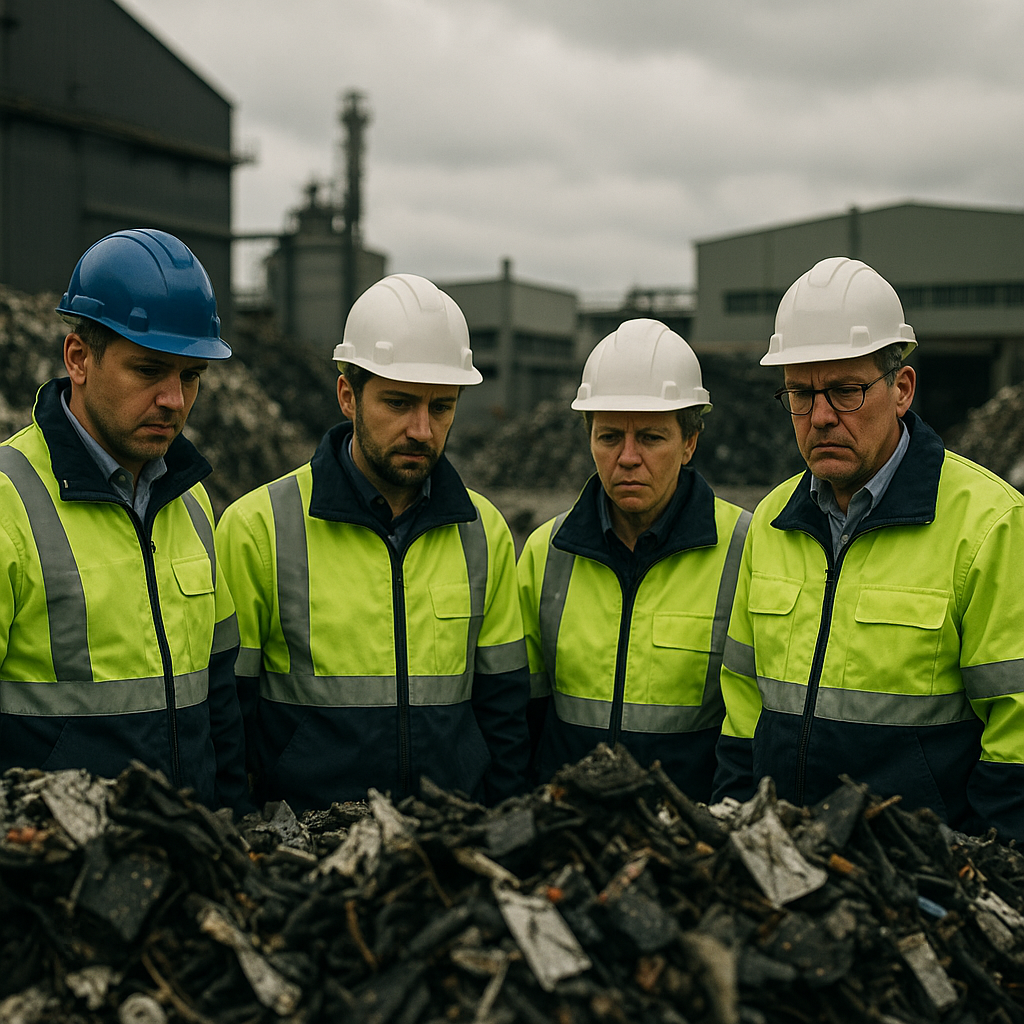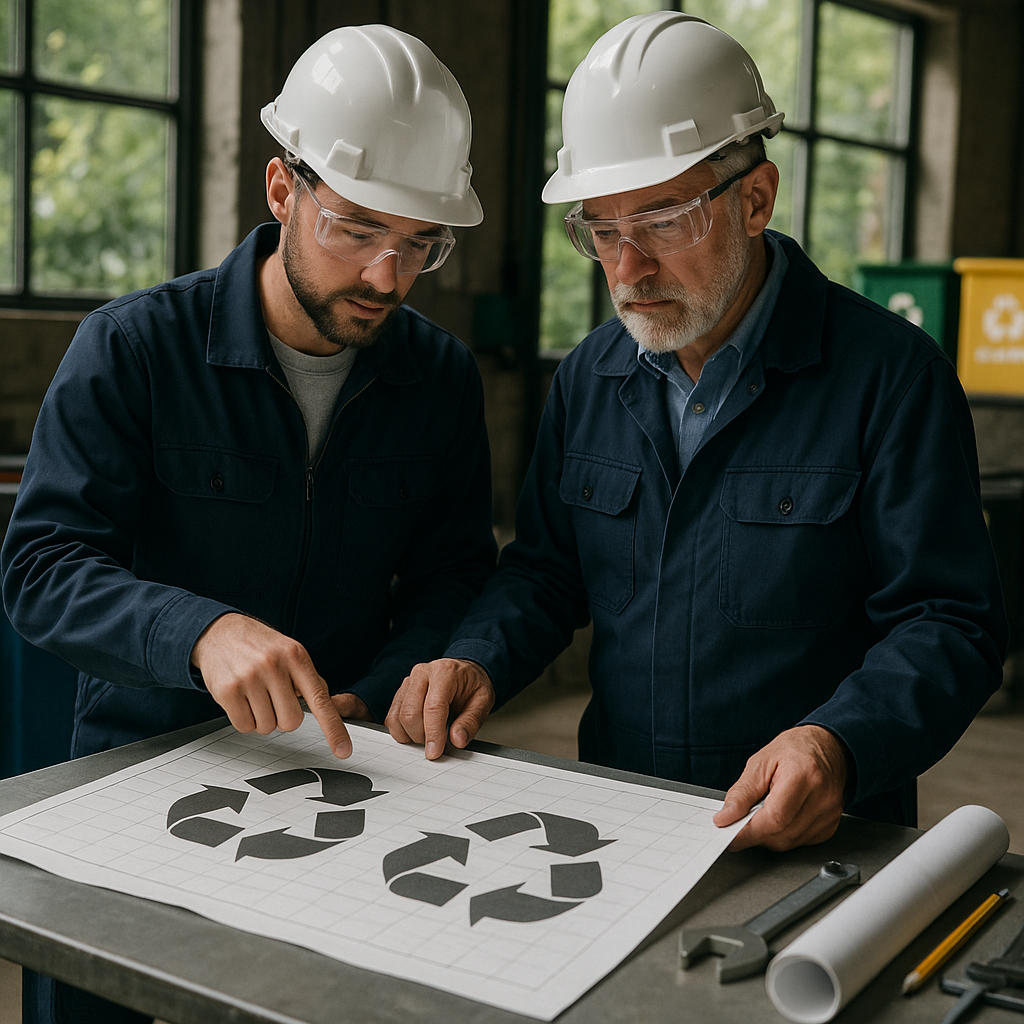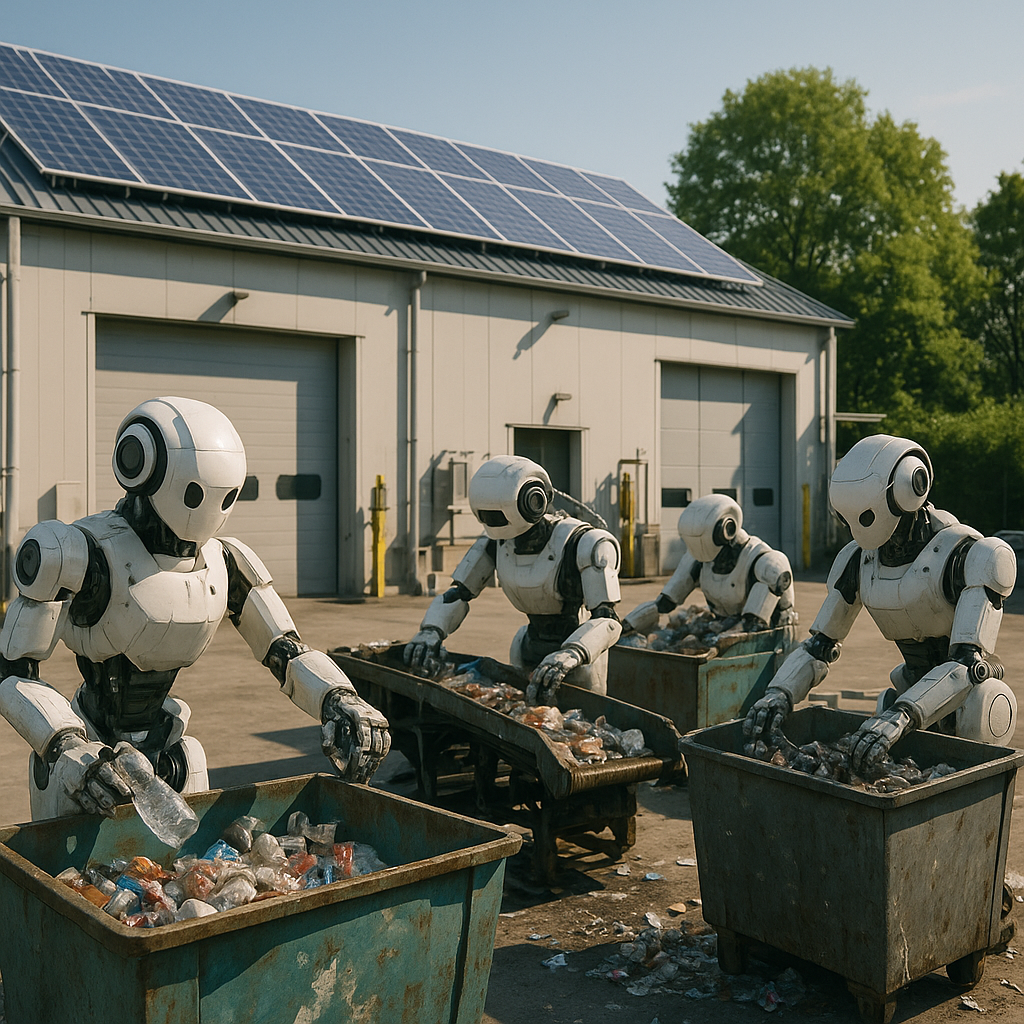5901 Botham Jean Blvd, Dallas, TX 75215
Industrial Byproducts: Challenges, Recycling Technologies, and Sustainable Management
September 8, 2025Industrial byproducts are secondary materials generated during manufacturing processes that aren’t part of the intended final product. These materials emerge as inevitable outputs when raw ingredients are transformed into consumer goods. Every day, manufacturing facilities around the world produce millions of tons of these byproducts.
Consider the food industry alone. Apple processing creates pomace (leftover pulp and skin), sugarcane extraction yields bagasse (fibrous residue), and cheese production generates whey (liquid remaining after milk coagulation). Even industrial giants in chemical production and mining operations create significant streams of byproducts during their regular activities.
The importance of these byproducts extends far beyond the factory floor. Their management directly impacts business profitability, environmental health, and community well-being. Without thoughtful handling, these materials become waste that fills landfills, contaminates water sources, and releases harmful emissions. With strategic management, however, they can be transformed into valuable resources.
What are the Key Challenges in Managing Industrial Byproducts?

Industrial byproducts present unique management challenges that complicate efficient handling, processing, and repurposing. Understanding these challenges is essential for developing effective recycling strategies. Here are the primary obstacles facilities face when managing these materials:
High Moisture Content
Excess moisture in industrial byproducts creates significant handling and storage difficulties. When moisture levels are high, materials become sticky and prone to clumping, affecting their flowability during processing and transport.
Moisture also accelerates microbial growth and spoilage in organic byproducts. Food processing residues with high water content can become breeding grounds for bacteria and molds within hours if not properly managed. This contamination risk limits storage options and shortens usable timeframes.
Water content impacts energy efficiency during processing. Wet materials require more energy to dry, increasing operational costs and the carbon footprint. A paper mill generating wet pulp residue may need extensive dewatering processes before the material becomes suitable for alternative uses.
- Clumping and poor flowability in transport systems
- Accelerated microbial growth and spoilage
- Increased energy requirements for processing
Composition Variability
Industrial byproducts often lack consistency in their makeup, complicating standardized processing and quality control. Batch-to-batch differences can render materials unpredictable for reuse applications.
Manufacturing facilities producing the same product may generate byproducts with different compositions based on production fluctuations. For instance, slag from steel manufacturing varies in mineral content depending on the source materials and processing conditions used that day.
This inconsistency creates challenges for end-users who require reliable materials. A concrete manufacturer incorporating industrial ash must ensure consistent performance properties, which is difficult when the ash composition varies.
- Unpredictable material properties
- Difficulty in establishing standardized processes
- Quality control complications for end-use applications
Harmful Substances
Many industrial byproducts contain potentially hazardous components that require careful handling, posing health risks to workers and environmental concerns if not properly managed.
Chemical manufacturing byproducts may contain residual solvents, heavy metals, or reactive compounds. Without proper identification and containment, these substances can pose serious safety hazards, potentially leading to workplace incidents and environmental contamination.
Safe management requires specialized equipment, training, and protocols. For example, spent catalysts from petroleum refining often contain heavy metals that require specialized handling equipment and personal protective gear during removal and processing.
- Worker safety concerns during handling
- Environmental contamination risks
- Need for specialized containment and processing equipment
Regulatory Constraints
Complex regulations govern industrial byproduct management across different jurisdictions, adding compliance costs and administrative burdens for facilities.
In many regions, byproducts are classified as waste until proven otherwise, triggering stringent handling, transportation, and disposal requirements that limit reuse options. For example, foundry sand that could potentially be repurposed as construction material may face regulatory barriers, making landfilling an easier option despite environmental impacts.
Obtaining permits for innovative reuse applications often involves lengthy approval processes. A manufacturing facility seeking to repurpose process residues as agricultural amendments may need extensive testing and documentation before receiving regulatory approval.
- Complex compliance requirements across jurisdictions
- Default waste classification limiting reuse options
- Time-consuming permitting processes for new applications
Sensory and Functional Limitations
When repurposed for consumer applications, industrial byproducts may have undesirable sensory or functional properties, restricting their use in certain markets.
Food industry byproducts repurposed for human consumption often face acceptability challenges. Fruit processing pulp may have off-flavors or textures that limit its incorporation into new food products without extensive modification.
Similarly, digestibility issues can affect byproducts repurposed as animal feed. Certain processing residues may contain anti-nutritional factors that reduce feed efficiency unless specially treated.
- Off-flavors, colors, or textures limiting consumer acceptance
- Digestibility challenges in feed applications
- Functionality differences compared to virgin materials
| Challenge | Description | Impact |
|---|---|---|
| High Moisture Content | Moisture levels too high lead to clumping and increased microbial growth, requiring more drying energy. | Transport issues, spoilage, increased processing costs |
| Composition Variability | Inconsistencies in byproduct makeup complicate processing and quality control. | Unpredictable performance in reuse, challenges in process standardization |
| Harmful Substances | Contains hazardous materials requiring careful handling to prevent contamination. | Worker safety risks, environmental hazards, need for specialized equipment |
| Regulatory Constraints | Complex regulations governing byproduct classification and disposal limit reuse options. | Increased compliance costs, limited reuse potential, lengthy approval processes |
| Sensory and Functional Limitations | Byproducts may possess off-flavors or require modification for consumer or agricultural applications. | Limited market acceptance, reduced functionality compared to virgin materials |
What Technologies are Transforming Byproduct Management?
The recycling industry is experiencing significant technological advances in byproduct management, helping businesses and municipalities transform waste into valuable resources. Here, we explore these innovative technologies.
Solvent Extraction
Solvent extraction separates compounds based on their solubility in different liquids. This method uses specific solvents to selectively dissolve and recover valuable components from waste materials. In food processing, it can recover essential oils and flavor compounds from byproducts.
Recent innovations include bio-based solvents derived from renewable resources like limonene and ethyl lactate. These eco-friendly alternatives offer comparable extraction efficiency while reducing environmental impact. Additionally, closed-loop solvent recovery systems are becoming popular, allowing for continuous solvent reuse and minimizing waste.
However, traditional solvent extraction often requires large amounts of potentially hazardous chemicals, leading to safety concerns and increased disposal costs. The process also demands significant energy for solvent removal and recovery.
Membrane Filtration
Membrane filtration technology separates components based on molecule size using semi-permeable barriers. This technology has revolutionized wastewater treatment by enabling the recovery of valuable compounds while producing clean, reusable water.
The latest membrane technologies address the challenge of fouling. ZwitterCo has developed membranes resistant to irreversible fouling that can handle up to 5% fats, oils, and greases, making filtration viable for previously unfilterable waste streams in heavy manufacturing.
Despite these advances, membrane systems struggle with highly viscous materials, and initial installation costs can be high, though many facilities achieve a positive ROI through water recovery and byproduct valorization.
Drying Techniques
Advanced drying technologies extend the shelf life of byproducts and reduce transportation costs by removing moisture. Modern techniques include freeze-drying, spray drying, and microwave drying, each with distinct advantages for different materials.
Freeze-drying preserves heat-sensitive compounds, while spray drying creates uniform powder products. These processes are particularly valuable for converting food processing byproducts into shelf-stable ingredients for secondary markets.
Energy requirements remain a significant challenge for drying processes. Manufacturers must weigh energy costs against the increased value of dried byproducts.
Fermentation
Fermentation transforms organic byproducts into high-value products through controlled microbial activity, converting sugars and other compounds into acids, alcohols, and gases.
In the food industry, fermentation can convert fruit and vegetable waste into vinegars, alcoholic beverages, and flavor enhancers. Agricultural byproducts can be fermented to produce biofuels, reducing dependence on fossil fuels.
The challenge with fermentation lies in maintaining consistent quality across batches. Process optimization requires careful control of temperature, pH, and microbial cultures, which can be technically demanding for smaller operations.
Enzymatic Hydrolysis
Enzymatic hydrolysis uses specific enzymes to break down complex materials into simpler, more valuable components, preserving the functional properties of proteins, carbohydrates, and other valuable compounds.
In paper manufacturing, enzymatic treatments can recover cellulose fibers from waste pulp. Food processing facilities use enzymes to extract proteins and bioactive compounds from production residues.
The primary limitations include the high cost of enzyme preparations and the need for precise process control. However, as enzyme technology advances and scales up, costs continue to decrease, making this approach more accessible.
Pyrolysis
Pyrolysis converts organic materials into energy and useful byproducts through heating in an oxygen-limited environment. This thermal decomposition process produces biochar, bio-oil, and synthesis gas from various waste streams.
Agricultural residues, food processing waste, and certain plastics can all serve as feedstock for pyrolysis systems. The resulting products have applications in energy generation, soil amendment, and chemical manufacturing.
While pyrolysis offers an effective waste-to-energy pathway, it requires significant capital investment. The process also demands careful emissions control to prevent the release of harmful compounds.
As these technologies continue to develop, their integration into recycling operations creates new opportunities for resource recovery and waste valorization. The most effective byproduct management strategies often combine multiple technologies, tailored to specific waste streams and desired outputs.
How Can Industries Implement Sustainable Byproduct Management?

Managing industrial byproducts is essential for sustainable operations. When done effectively, it transforms waste into valuable resources and reduces environmental impact. The key is adopting a structured approach that prioritizes prevention, then explores reuse and recycling options before considering disposal.
Adopt the Waste Hierarchy Approach
The waste hierarchy offers a framework for sustainable byproduct management. This method ranks waste management options from most to least environmentally preferred: start with prevention, proceed to reuse, then recycling, recovery, and finally disposal as a last resort.
Industries can apply this hierarchy by first analyzing production processes to identify where waste can be eliminated. For unavoidable materials, establish systems for reuse within operations. Only when prevention and reuse are exhausted should recycling and other recovery methods come into play.
Conduct Comprehensive Waste Audits
Effective byproduct management begins with understanding the waste streams in operations. Conduct detailed audits to identify types, volumes, and sources of byproducts generated. These audits highlight opportunities for reduction and provide baseline data to measure improvement.
Monitoring waste generation patterns over time helps identify seasonal fluctuations or production spikes, aiding in planning appropriate management strategies and sizing treatment systems correctly. Regular audits also verify the effectiveness of waste reduction initiatives.
Optimize Production Processes
Process optimization is crucial for reducing byproduct generation at the source. Industries should evaluate manufacturing methods to identify inefficiencies that create excess waste. This might involve adjusting equipment settings, improving maintenance schedules, or upgrading to more efficient technologies.
For instance, in the food and beverage sector, high water and energy usage contribute significantly to waste. Implementing closed-loop water solutions can significantly reduce consumption and wastewater output by filtering, purifying, and reintroducing water into production cycles.
Explore Innovative Uses for Byproducts
Many industrial byproducts can become valuable inputs for other processes. Companies should explore innovative applications for materials that would otherwise be discarded, potentially partnering with other industries that can use these byproducts as raw materials.
For example, some food manufacturers have transformed organic waste into bioenergy, converting byproducts into biogas or biomass fuel. Other industries have implemented waste-to-energy and alternative engineered fuel technologies, processing waste into steam, electricity, or fuel.
Invest in Treatment Technologies
For byproducts that cannot be eliminated, reused, or recycled, appropriate treatment technologies are essential. These technologies can reduce toxicity, volume, or convert waste into more manageable forms. Investing in the right treatment solutions depends on the specific byproducts generated.
Anaerobic digestion systems can process organic wastes while generating biogas, and wastewater treatment facilities can remove contaminants before discharge. For hazardous byproducts, specialized treatment may be necessary to neutralize harmful components before disposal.
Implement Waste Exchange Programs
Waste exchange initiatives reflect circular economy principles by enabling byproducts from one process to act as inputs for another. These programs connect companies with complementary waste and resource needs, fostering industrial symbiosis.
By implementing such initiatives, businesses can reduce landfill reliance and support sustainable resource use. These exchanges can occur within different departments of a company or between separate organizations, creating networks of resource efficiency.
Collaborate Across the Supply Chain
Sustainable byproduct management extends beyond a single facility. Cooperation with suppliers, customers, and other stakeholders is crucial for developing effective circular economy solutions.
Work with suppliers to reduce packaging waste or implement take-back programs for materials. Engage customers in product end-of-life management strategies. Join industry associations or regional initiatives focused on byproduct management to share best practices and explore collaborative solutions.
Measure and Track Progress
Establishing clear metrics and tracking systems is critical for sustainable byproduct management. Define key performance indicators like waste reduction percentages, recycling rates, or cost savings from reuse programs. Regular reporting keeps these initiatives visible and helps maintain momentum.
Data from tracking systems can highlight areas needing improvement and demonstrate the business case for continued investment in sustainable practices. Success stories should be shared across the organization to build support and engagement.
Train and Engage Employees
Employee involvement is vital to any byproduct management program’s success. Provide comprehensive training on waste reduction procedures and the importance of proper segregation, encouraging a culture where waste prevention is everyone’s responsibility.
Encourage employees to contribute ideas for reducing byproducts or finding new uses for waste materials. Their firsthand experience with processes often leads to practical, effective solutions that might not be obvious to management.
Implementing sustainable byproduct management is an ongoing commitment to continuous improvement. By systematically applying these strategies, industries can significantly reduce their environmental footprint while potentially discovering new value in materials previously considered waste.
Conclusion: The Future of Industrial Byproduct Management

Effective management of industrial byproducts has become a cornerstone of sustainable manufacturing. As industries progress, transforming byproducts from waste into valuable resources brings both environmental benefits and economic opportunities. Technologies like AI-driven sorting systems, IoT sensors, and advanced recycling methods are transforming how industries handle these materials.
The shift toward circular economy principles is gaining traction across manufacturing sectors. From reusing metal scraps to converting organic byproducts into bioenergy, innovative companies are finding ways to close material loops. This approach not only reduces waste but also creates new revenue streams while minimizing environmental impact. Regulatory frameworks are evolving to encourage these sustainable practices, guiding industries toward more responsible byproduct management.
For assistance with recycling industrial metal, contact Okon Recycling at 214-717-4083. Our experts can help transform your waste streams into valuable resources while ensuring regulatory compliance and supporting your sustainability goals.
